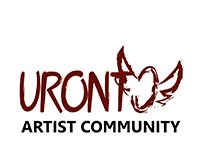
15 Apr URONTO Residential Art Exchange Program- 3rd Episode
The third Episode was located in the Old House of Kalikananda Chattyapaddhay at Ishwaripur Shatkhira, Bangladesh. Ishwaripur is one of the historically famous villages in Bangladesh. It was the capital of Raja Pratipaditya in late sixteen and early 17th century. Ishwaripur has many beautiful sites.
The actual house chosen for the project was at-least 400 years old. It was in immaculate condition even in the 1st decade of the 20th century. The huge boundary gate was guarded by the statue of a lion. As you would enter the gate, first you would have seen five courtyards at the entrance. On the left was a two-storied building with an eight-paneled roof. The bottom of the building use to have a small Zoo and above it, was a museum created and maintained by Srishchandra Chattopadhyay (, guardian priest and president of Ishwaripur union board, member of local board and member, Jury board, Khulna Judge court.). Adjacent to the zoo, there were large imposing three-storied buildings. Those buildings had eight stairways, and eighty-eight rooms. Around in 1962-63 a delimited road was constructed by abolishing a portion of the building. And in 1965 using bricks from a portion of that building, a local primary school was built. The school is developed now as the Ishwaripur United High School. About 100 years back keeping one small portion intact and breaking the remaining part of the house, three new beautiful buildings were constructed.

One among those three building which was actually constructed keeping the old structure is the building Uronto team is located there project in the 3rd episode. After the first world war Historian & Archeologist Kalikananda Chattapadhyay (1899-1987) the family member designed and built that nice new house on a part of that old foundation. That is a Huge Structure with beautiful high windows standing from the floor. Balconies on both side and wide staircase in front of one of balcony with runner on both side. That balcony was designed keeping the front theatre stage in mind. Flower garden on the both sides till the end of the yard touching the wide road at the end. The best part of the house was the room under the staircase inside the house. Red smooth cemented floor with coiled stairs which ended on the upper floor facing four rooms and four doors which lead to the veranda. In that very room recitation artist and actor Jayanto Chattapadhyay and writer of History of Satkhira District `Baghratath Parikraman’ (retrospective of tiger cost) Jyoti Chattapadhaya were born.
At the beginning of 1971 liberation war till April the condition of the house was quite the same. It was then used by the Razakars and the Peace committee. But now in 2014 all these facts and beauties of the house can hardly be found. Now the house is standing on its last legs. One who don’t know the previous stories can hardly imagine the house like before.
Participating Artist were invited to deliver an aesthetical expression about the history, beauty, importance etc of this old structure in their won media collaborating with local artist and community. The core theme of every work was anything and everything about the palace and its surroundings.







pratik cam work pic 



In this Episode Artists from India, Bangladesh and UK came together under one roof. Mansi Verma, Pratick Bhattacharjee, Pinak Banik, Liton sen, Krishna Chattyapaddhay, Prokriti Chattyapadhhay, Jyoti Chattyapadhhay Salam Jones, Amdadul hoque were the core participants but few other from the local community also participated. There were interactive reading sessions conducted by artist and participated by locals. Most of the works were collaborative efforts which helped spread a common genre of Art among the local community successfully.
The Project started by 21 March’14 and continued until 26th March 2014. The last day was the open Studio day, which was a full house with crowds form local villages and schools.
Detail of all the works done in the Programme will be soon uploaded in the archive section.
URONTO is hosting site responsive residential art exchange programmes since 2012 within disused or abandoned spaces and heritage buildings to document cultural memories and brand Bangladesh globally through multidisciplinary artists’ collaborations. URONTO’s activities not only provide much-needed opportunities for emerging artists to expand their working practice and collaborate with international artists, but through each residency, they create an alternative documentation about the history of the selected site before it’s demolished and forgotten.
The Project invite artists and practitioners through open call and selects then through a curatorial board created newly for every Episode. It is an international program open for all kind of discipline.




No Comments